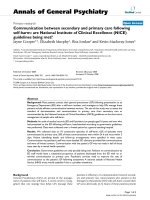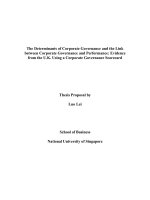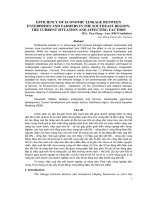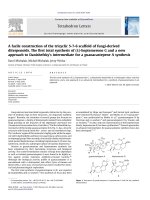Between fathers and fetuses - the social construction of male reproduction and the politics of fetal harm
Bạn đang xem bản rút gọn của tài liệu. Xem và tải ngay bản đầy đủ của tài liệu tại đây (196.73 KB, 18 trang )
7
Between fathers and fetuses: the social
construction of male reproduction and the
politics of fetal harm
Cynthia R. Daniels
Political Science Department, Rutger University, New Brunswick, USA
In contemporary American political discourse ‘crack babies’ have been
treated as Wlius nullius – as if they had no biological fathers. With no link
between fathers and fetuses, no inheritance of harm could be attributed to the
father’s use of drugs. The absence of fathers in debates over drug addiction
and fetal harm has had profound consequences for women, for it has dictated
that women alone bear the burden and blame for the production of ‘crack
babies’.
Since at least the late 1980s, and in some cases far earlier, studies have
shown a clear link between paternal exposures to drugs, alcohol, smoking,
environmental and occupational toxins, and fetal health problems. Yet men
have been spared the retribution aimed at women. In fact, while women are
targeted as the primary source of fetal health problems, reports of male
reproductive harm often place sperm at the centre of discourse as the ‘littlest
ones’ victimized by reproductive toxins, somehow without involving their
male makers as responsible agents.
ScientiWc research linking reproductive toxins to fetal health problems
reXects deeply embedded assumptions about men and women’s relation to
reproductive biology. Critical analysis of the nature of fetal risks thus requires
not only examination of the biology of risk, but also assessment of what
Evelyn Fox Keller has called the ‘collective consciousness’ that fundamentally
shapes scientiWc inquiry on gender diVerence – a consciousness that is
constituted by ‘a set of beliefs given existence by language rather than by
bodies’ (Keller, 1992: p. 25).
In debates over fetal harm, the production of this collective consciousness
takes place in many social locations: in science laboratories, where the
priorities of research are deWned; in editorial rooms, where reporters decide
which news warrants coverage and what slant to take on stories; and in courts
and legislatures, where decisions are made regarding the deWnition of and
culpability for social problems.
This chapter examines the cultural characterizations of sperm and male
reproduction in science, news stories and public policy, all of which have
113
shielded men from culpability for fetal health problems. (A more detailed
discussion of the rise of the concept of fetal rights and fetal protectionism can
be found in Daniels, 1993.) After a brief discussion of the social construction
of maternity and paternity, I analyse the symbols of the ‘crack baby’, ‘preg-
nant addict’ and ‘absent father’ as central to public discourse on fetal harm,
particularly in the US. Finally, I explore the range of complex questions about
biological gender diVerence generated by the politics of fetal risks, and the
problematic nature of the idea of individual causality in discussions of fetal
harm.
Social constructions of maternity and paternity
In Western industrial cultures, notions of masculinity have been historically
associated with the denial of men’s physical vulnerabilities and bodily needs,
which are instead projected onto the maternal body. Debates over fetal harm
have been constituted by the analytically distinct and antithetical categories
of male virility and vulnerability. Men were assumed either to be invulnerable
to harm from the toxicity of drugs, alcohol and environmental and occupa-
tional hazards, or to be rendered completely infertile by any vulnerability to
risk. In particular, sperm that crossed the line from virile to vulnerable by
being damaged by reproductive toxins were assumed to be incapable of
fertilization. And the converse operated as well – men not rendered infertile
by their toxic exposures were assumed to be immune from any other form of
reproductive risk (such as genetic damage).
Social constructions of maternity, by contrast, have been Wrmly aligned
with assumptions of women’s vulnerability. The science of reproductive risks
historically developed in response to women’s occupational exposures, where
it was assumed that the physical stress and toxic exposures of the workplace
would result in the degeneration of women’s reproductive systems. Protec-
tive labour law selectively exaggerated the vulnerabilities of white women to
occupational hazards and virtually ignored risks to working women of colour
(Baer, 1978; Kessler-Harris, 1982; Lehrer, 1987; Daniels, 1991, 1993). Until
well into the twentieth century, science, policy and law deeply reXected the
association of maternity with vulnerability.
The cultural associations of paternity with virility and maternity with
vulnerability formed the context within which the symbols of the ‘crack
baby’, ‘pregnant addict’ and ‘absent father’ emerged at the center of debate
over fetal hazards. (A more detailed analysis of the social and political
construction of these concepts can be found in my longer treatment of this
issue in Daniels, 1993, where I analyse the science, media, policy and law
discourses surrounding the emergence of the ideas of fetal protectionism and
fetal rights.)
114 C.R. Daniels
‘Crack babies’ and ‘pregnant addicts’
By now, the images of the crack baby and addicted mother are familiar to
anyone who has read news reports of pregnancy and addiction. In the US,
media attention began to focus in 1988 on babies aVected by maternal drug
use, with the release of a study by Dr. Ira ChasnoV, director of the National
Association for Perinatal Addiction Research and Education (NAPARE),
which reported that 375 000 babies were born every year ‘exposed to illicit
drugs in the womb’ (ChasnoV, 1989: pp. 208–10). The study was fundamen-
tally Xawed in a number of ways. ChasnoV’s sample was biased by the fact
that 34 of the 36 hospitals surveyed were public inner-city hospitals. The
study made no distinction between a single use of illegal drugs and chronic
drug addiction during pregnancy; nor did it document the actual eVects of
drug use on newborn infants.
The limitations of the study were never reported. Instead, the press picked
up and exaggerated ChasnoV’s Wndings, often reporting that 375 000 babies
were born every year ‘addicted to cocaine’ (Brody, 1988: p. 1; Stone, 1989:
p. 3). As the distinctions between drug use and abuse collapsed, the reported
numbers of crack babies exploded. By 1990, news stories reported that one
out of every ten children was born ‘addicted to crack cocaine’ or damaged by
women’s use of drugs (Daniels, 1993). By 1993, nine inXuential national daily
newspapers in the United States had run more than 197 stories on pregnancy
and cocaine addiction alone (including the New York Times, Wall Street
Journal, Washington Post, Christian Science Monitor, Los Angeles Times,
Chicago Tribune, Boston Globe, Atlanta Constitution/Atlanta Journal and USA
Today).
The mindset created by this public discourse encouraged physicians,
nurses and social workers to attribute many serious problems experienced by
infants at birth to the use of drugs or alcohol by the child’s mother, particu-
larly in low-income inner-city neighbourhoods.
Symptoms associated with ‘crack babies’ ranged from very speciWc condi-
tions that could, in fact, be tied to maternal drug use (such as drug with-
drawal symptoms) to low birth weight, small head circumference, irritability,
respiratory problems, gastrointestinal problems and diarrhoea – conditions
that could easily be caused by poor nutrition or a host of environmental
factors. (For a complete discussion of the symptoms associated with fetal
cocaine exposure, see Zuckerman, 1991: pp. 26–35.) More highly controlled
studies estimated that approximately 41 000 babies were born annually in the
US with clear symptoms of drug-related health problems (such as drug
withdrawal symptoms), a far cry from the 375 000, presented by NAPARE, as
exposed to drugs in the womb (Dicker and Leighton, 1990). The results of
these studies were never reported by the national press, just as the press rarely
reports research showing little or no association between moderate drug and
115Between fathers and fetuses
alcohol use and fetal health problems (Koren and Klein, 1991). There are two
stages to the ‘screening’ process by which research makes it into the press.
First, science journals review, accept or reject reports of Wndings. Koren at el.
(1989) found that professional scientiWc journals were predisposed against
reporting negative or ‘null’ associations between drug use and fetal risks.
Once scientiWc reports did begin to appear in journals, Koren and Klein
(1991) found a similar predisposition in the press against reporting negative
Wndings.
The sense of social distress created by images of addicted babies wired to
tubes in hospital incubators fed a profound need to blame. Public concern
over crack babies contains all of the characteristics of a response to plague –
fuelling the impulse of privileged populations to locate, target and contain
one group as the primary source of contamination and risk (Mack, 1991). As
Linda Singer has observed in relation to the spread of AIDS, the epidemic
‘provides an occasion and rationale for multiplying points of intervention
into the lives and bodies of populations’ (Singer, 1993: p. 117). The policy
response to the plague narrative was to Wnd a target population to blame, and
poor inner-city women were the most obvious targets. Newspaper stories
contributed to this impulse by presenting images of African–American
women as virtual monsters, snorting cocaine on the way to the delivery room
and abandoning horribly damaged babies in hospitals. In some instances,
drug use was characterized as a form of child abuse in utero, where cocaine
‘literally batters the developing child’ (see Brody, 1988: p. 1; Stone, 1989:
p. 3).
Criminal prosecutors responded to the sense of crisis by targeting pregnant
women for prosecution. By 1993, between 200 and 400 women had been
charged with fetal drug delivery, fetal abuse or manslaughter (in cases where
the pregnancy had ended in a stillbirth). Despite the fact that nearly every
case challenged in the courts has resulted in the dismissal or acquittal of
charges against women, prosecutors continue to bring criminal charges
against women they suspect of drug or alcohol use during pregnancy. To
date, almost all of these cases have been brought against African–American
women (Paltrow, 1992). (However, it is diYcult to calculate total numbers,
since so many women are charged by local prosecutors who do not report
their cases to any central national source.)
What has been the response of state and federal public health agencies to
women and fetal health? Public health departments have produced warning
labels on wine, beer, and liquor bottles and cigarette packages, together with
an avalanche of public notices about pregnancy and alcohol consumption in
restaurants and bars. Such labels stigmatize women by perpetuating assump-
tions that only women are vulnerable to risk and that women, therefore, are
the primary source of fetal harm. Men are left entirely out of the frame as
social attention focuses exclusively on the maternal–fetal nexus.
116 C.R. Daniels
By implying women’s ignorance or ill intentions, public health warnings
aimed at pregnant women legitimate an atmosphere that encourages public
retribution against women, by focusing exclusively on individual behaviour
and not on the social and political causes of low birth weight, fetal birth
defects or other health problems. Retribution is invited by the fact that public
health warnings aimed at men (e.g. for heart disease, high blood pressure,
cigarette smoking and steroid use) focus on behaviours that cause harm to
self, whereas messages aimed at women focus exclusively on women’s harm
to others (the fetus).
One New Jersey public health advertisement displays an image of a preg-
nant woman holding a drink and warns, ‘A pregnant woman never drinks
alone’ (N.J. Perinatal Cooperative, 1993). Yet a pregnant woman also never
drinks in isolation from the eVects of her home, her job and her physical,
social and political environment. Even symptoms speciWc to drug or alcohol
abuse, such as drug withdrawal symptoms or fetal alcohol syndrome, are
complicated by simple factors such as poor nutrition. For instance, one study
of pregnancy and alcohol use (controlling for age, smoking, drug abuse,
reproductive history, medical problems, socio-economic status and race)
found that women who consumed at least three drinks a day but ate balanced
diets experienced a rate of fetal alcohol syndrome (FAS) of only 4.5 per cent,
while women who drank the same amount and were malnourished had an
FAS rate of 71 per cent (Bingol et al., 1987). The study showed that poor
nutrition is tied directly to income – FAS is a measure not only of maternal
alcoholism but also of economic class. There has been no press coverage of
this study.
Public campaigns to ‘stem the tide of crack babies’ are clearly racialized,
primarily targeting women of colour in low-income communities. ScientiWc
research has supported the racialized nature of debate by focusing research
heavily on drugs used most commonly in poor inner cities (such as crack)
and not on substances most often abused by higher-income women (such as
prescription drugs). Public health warnings typically silhouette African–
American or Latina women; they are often produced in Spanish and directed
at inner-city neighbourhoods.
Counteracting the symbol of the pregnant addict requires breaking the
exclusive connection between pregnant women and ‘crack babies’. The circle
of causality has widened since feminist advocates started inXuencing media
coverage of the issue, and since news stories began suggesting the relation on
fetal health of the combined eVects of poverty, addiction and exposures to
workplace and environmental toxins. The precise causes of fetal health
problems are immensely complicated. A woman living in the inner city is
likely to have had little health care before she became pregnant, and also poor
antenatal care. If she is employed in a hospital, she might be exposed to
radiation, chemotherapeutic drugs, viruses or sterilizants such as ethylene
117Between fathers and fetuses
oxide. If she works in a laundrette or dry cleaners, she might be exposed to
solvents, cleaners or excessive heat. If she works in a factory, she might be
required to do heavy lifting, or she might be exposed to toxic chemicals and
the dust of heavy metals. If she lives in a low-income neighbourhood, she is
likely to be exposed to lead from outdated plumbing or in the dust from old
paint (Massachusetts Coalition for Occupational Safety and Health, 1992).
But drawing fathers into the circle of causality, essential to a deconstruc-
tion of the symbol of the pregnant addict, has proved more diYcult.
Both metaphorically and literally, fathers were absent from virtually all of the
news stories on fetal health and addiction. The absence of fathers in news
reports of crack babies was made easier to believe by the racial subtext of the
story: African–American women are often characterized as abandoned, single
mothers – women dangerously unconstrained by nuclear family relations.
The absent father came to represent not only men’s physical distance from
the out-of-wedlock child but also men’s distance from fetal harm.
Virile fathers and the ‘all or nothing’ sperm theory
Embedded in scientiWc research and newspaper and magazine stories were
further assumptions about male reproduction that posed serious barriers to
the father/fetal connection. ScientiWc literature on reproductive toxicity has
traditionally dismissed the links between paternal use of drugs and alcohol
(or exposure to occupational or environmental toxins) and harm to fetal
health, because it was assumed that damaged sperm were incapable of
fertilizing eggs. Indeed, male reproductive success was deWned as the ability to
penetrate an egg. Because penetration was the measure of normality, those
sperm that succeeded were assumed to be healthy. By deWning male repro-
ductive health along the principles of this ‘all or nothing’ theory, most
scientiWc studies until the late 1980s dismissed the possibility that defective
sperm could contribute to fetal health problems. The ‘all or nothing’ theory
was based on certain culturally imbued assumptions about the reproductive
process. As Emily Martin has so well documented, scientists characterized the
egg as the passive recipient and the sperm as conqueror in the process of
fertilization (Martin, 1991).
The assumption that men harmed by toxic exposures would be rendered
infertile deXected research away from the connections between fathers and
fetal harm. As a result of the ‘virile sperm’ theory of conception, scientiWc
studies, until the late 1980s, focused almost exclusively on infertility as the
primary outcome of hazardous exposures and the main source of reproduc-
tive problems for men. Male reproductive health was deWned by ‘total sperm
ejaculate’, and healthy reproductive function was measured by ‘ejaculatory
performance’ – measures of volume, sperm concentration and number,
sperm velocity and motility, sperm swimming characteristics, and sperm
morphology, shape and size (Burger et al., 1989).
118 C.R. Daniels
Scientists who did try to pursue the father–fetal connection, such as Gladys
Friedler at Boston University – who was the Wrst to document a link in mice
between paternal exposure to morphine and birth defects in their oVspring in
the 1970s – had diYculty funding their research or publishing their work.
The signiWcance of Friedler’s work is that she found mutagenic eVects from
paternal exposures not only in the progeny of male mice exposed to mor-
phine and alcohol, but also in the second generation or ‘grandchildren’ of
exposed mice. In all cases, she controlled for maternal exposures so that
causality could be more clearly linked to paternal exposures (Friedler and
Wheeling, 1979; Friedler, 1985, Friedler, 1987–8).
A number of social and political events generated the Wrst studies linking
environmental exposures to male reproductive harm. The cultural construc-
tion of male reproduction was particularly evident in these early studies.
In 1979, scientiWc concern was raised by a study in Florida that docu-
mented a 40 per cent overall drop in sperm count for men over the past 50
years. Scientists responded with ‘a Xurry of sperm-count studies’ about ‘the
big drop’ (Castleman, 1993). By 1990, researchers at the University of
Copenhagen had examined 61 sperm-count studies and determined that
there had, in fact, been a 42 per cent decline in sperm count over the past 50
years, from 113 to 66 million per millilitre of semen (Carlsen et al., 1992).
While this was far from the 20 million generally assumed to be the minimum
for male fertility, it raised concern lest the downward trend should continue.
Remarkably, in searching for a cause, scientists Wrst focused on the fashion
shift from boxer shorts to jockey shorts. Heat kills sperm, and because jockey
shorts hold the testicles close to the body, they might decrease sperm
production. The researchers also suspected increased sexual activity. Men
who engage in frequent sex have lower sperm counts than men who wait a
number of days between sexual encounters. After controlling for both prom-
iscuity levels and discounting the ‘jockey shorts’ thesis, the Copenhagen
researchers found an association between the increase in testicular cancer in
key countries and substantial sperm-count declines. They speculated that the
aetiology of both could be found in exposures to environmental toxins
(Carlsen et al., 1992). Although still concentrating on male fertility, rather
than on potential links between paternal exposure and fetal harm, the
Copenhagen study did suggest that sperm might be more vulnerable to
hazards than previously assumed, and that more research was needed on the
potential links between toxic exposures and male reproductive health prob-
lems. But the links between paternal exposures and fetal health problems
would not fully emerge until the assumption that damaged sperm were
incapable of fertilization was thrown into question by a larger shift in the
dominant paradigm of fertility and reproduction, a shift generated by the
development of the ‘seductive egg’ theory.
119Between fathers and fetuses









